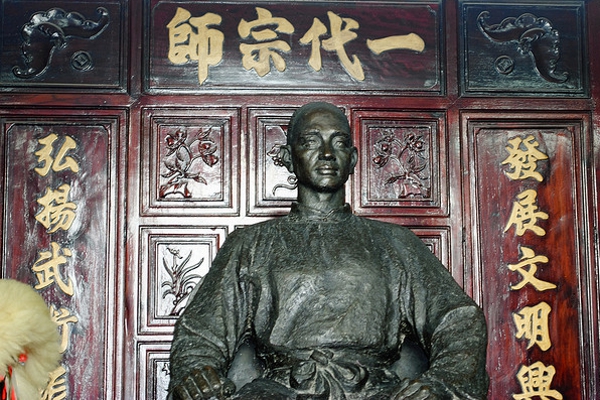
Fei-hung Wong (Chinese: Wong Fei-hung) was born on July 9, 1847 in Mount Xiqiao, Foshan, Guangdong in the reign of the Daoguang Emperor in the late Qing Dynasty. He was a Chinese martial artist, physician, acupuncturist, and revolutionary, who became a folk hero and the subject of numerous films and television series.
Fei-hung Wong was considered an expert in the Hung Gar style of Chinese martial arts. He began studying Hung Gar at the age of five, under his father, Kei-ying Wong (Chinese: Wong Kei-ying). When he was 13, he trained in the essentials of the Iron Wire Fist and sling from Lam Fuk-sing, a student of “Iron Bridge Three” Leung Kwan, after meeting Lam Fuk-sing in Douzhixiang during a martial arts street performance. Some time later he learned the “Shadowless Kick” from Sung Fai-tong.
As one of the best known Hung Gar practitioners in modern times, Fei-hung Wong and his martial arts lineage have received a lot of attention. As a physician, Wong practiced and taught acupuncture and other forms of traditional Chinese medicine in Po-chi-lam, his private clinic in Foshan, Guangdong.
Fei-hung Wong was only 17 when he set up his first martial arts school in Shuijiao. It was 1863. In 1886, 26 years later, he opened his Po-chi-lam clinic at Ren’an.
In 1919 Fei-hung Wong was invited to perform at the Chin Woo Athletic Association’s Guangzhou branch during its opening ceremony.
Fei-hung Wong was a master of Hung Gar or Hung Fist. He was the first master to create a system of the style and he choreographed Hung Gar’s version of the Tiger Crane Paired Form Fist, which incorporates his Ten Special Fist techniques. Wong is famous for using the Shadowless Kick and it was Wong who named each of the techniques he used.
Fei-hung Wong was said to be a weapons expert there is a tale that recounts how he defeated 30 gangsters on the docks of Guangdong with a staff. He also was known to use the southern tiger fork.
Fei-hung Wong is sometimes incorrectly identified as one of the “Ten Tigers of Canton”, but this is not the case. His father, Kei-ying Wong, was one of the ten tigers. Sometimes Fei-hung Wong is referred to as the “Tiger after the Ten Tigers”.
Fei-hung Wong’s had a number of famous students including his son, Hon-hei Wong, as well as Sai-wing Lam, Foon Leung, Dang Fong, Sai-wing Wong and Wan-kai Ling . Wong is often associated with the Ten Tigers of Canton in folk tales.
On May 24, 1924 in Chengxi Fangbian Hospital in Guangdong, Fei-hung Wong died of an illness. He was buried at the foot of Baiyun Mountain.
Fei-hung Wong’s wife, Kwai-lan Mok, and his two sons, along with his students Sai-wing Lam and Sai-king Dang , later moved to Hong Kong where they established martial arts schools.
A museum dedicated to Fei-hung Wong was built in Foshan.





